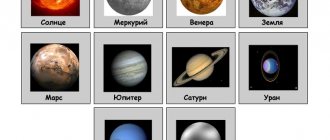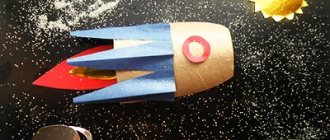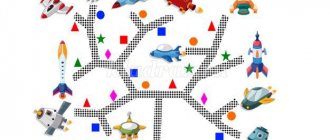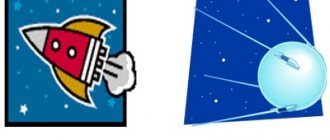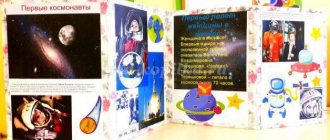Creative project on the theme “Space” with presentation, 2nd grade
Creative project on the surrounding world on the theme: “Mysterious space”
Several decades ago, few of yesterday's boys did not want to become an astronaut.
This dream is not at all relevant for modern children. Meanwhile, space pirates, star wars and other alien creatures are the heroes of your favorite cartoons. Interest in Space awakens in a person very early, literally from the first steps. The mysteries of the Universe always excite the imagination, from early childhood to old age. The sun, the moon, the stars are at the same time so close, and at the same time so far away. I think that each of us, including me, finds it very interesting to look at the night sky. That is why I chose the theme of the project : “The Mysterious World of Space.” Problem: Insufficient knowledge in the field of cognitive development, the history of space exploration, what is there behind the clouds of our beloved planet. Hypothesis: the most mysterious and fascinating thing in the world is space. Purpose of the work: To get acquainted with the history of space exploration. Objectives : - study additional literature; - select and organize interesting information; - provide facts that prove the mystery and wonder of space; — make visual models of the solar system. Stages of work: Preparatory stage
1. Selecting a topic.
2. Identification of questions on this topic. 3. Collection of information, its analysis and synthesis. Practical stage
1. Visit to library No. 9.
2. Analysis of the collected information. 3. Design of material, production of models of the solar system. 4. Research results Summary stage
1. Preparation and execution of the project presentation. 2. Protection of project work. 3. Analysis of the degree to which classmates have mastered the provided material.
Creative work
Layout No. 1 “Solar system”
Stages of work: 1. Print out the planets of the solar system, star background and laminate. 2. Cut out the planets and create a three-dimensional image using tape and foam plastic. 3. We arrange the planets in the required sequence. For work we used the following materials: - adhesive tape; - Styrofoam; - scissors; - laminating paper - decorative elements.
We got a very beautiful, three-dimensional image of the planets of the solar system. This layout can be widely used for educational purposes. Layout No. 2 “Solar System”
Stages of work: 1. Print out the star background. 2. Cut out a circle from foam plastic, onto which we glue a star background. 3. Model the planets using plasticine. 3. We arrange the planets in the required sequence on a starry background using toothpicks. For work we used the following materials: - glue; - Styrofoam; - scissors; - plasticine - toothpicks.
We got a very beautiful image of the planets of the solar system.
This layout can be widely used for educational purposes. In the course of our research, we found answers to many questions that interest us. We read a lot of scientific literature on this topic, studied the main stages of space exploration, and became acquainted with interesting facts about the planets of the solar system. There is so much still unexplored in the Universe! Billions of Stars and Planets. And maybe there is life on some that is at least a little similar to ours... The study of the mysterious cosmos continues! Thus, the research hypothesis was confirmed. While working on the project, I learned a lot of new things about space and the planets of the solar system, expanded my vocabulary, and broadened my horizons. The result of the work was that my classmates became acquainted with my work in class and enriched them with new knowledge. Presentation on the topic: Mysterious space
Download Creative project on the surrounding world on the theme “Mysterious Space”
We recommend watching:
Quiz game for Cosmonautics Day in primary school, grades 2-3 Extracurricular activities for Cosmonautics Day for grades 2-3 Game program for Cosmonautics Day for children 6-8 years old Quiz about space with answers, grade 4
Similar articles:
Zodiac constellations. Report, 4th grade
About the planets of the solar system for 4th grade children
Message about the Universe, 4th grade
Report about the Galaxy, 4th grade
A message about the Milky Way briefly, grade 4
First flight into space: facts
Space conquered man in 1961, the first Soviet cosmonaut was Yuri Alekseevich Gagarin - even a child knows these facts in the post-Soviet space. Even earlier, two dogs flew into space - many people also know about this.
Fun fact: before the flight, the famous Belka and Strelka were called Alba and Marquise, but the dogs' names were changed at the direction of the Soviet government.
But the very first living creature to go into space was the dog Laika. On November 3, 1957, Laika found herself in space on the Sputnik 2 spacecraft and died 6 hours later due to overheating of the capsule in which she was located. In total, 65 animals served for the benefit of the Russian cosmonautics: dogs, monkeys, rabbits. Due to various problems, 27 animals died. And only when the flights of four-legged astronauts began to be successful did they decide to send the first man into outer space.
The first manned flight into space on April 12, 1961 over time became overgrown with rumors and legends. But there are also reliable facts related to Yuri Gagarin’s flight, confirmed by participants and witnesses of the events:
- For a long time, chief designer Sergei Korolev could not decide who would become the first cosmonaut in the world - Yuri Gagarin or German Titov. Korolev, according to entries in his diary, considered Titov better prepared than Gagarin. That is why German Titov flew second - the second flight was technically more difficult than the first.
- Yuri Alekseevich’s build played an important role in the selection of the first cosmonaut: Vostok-1 had a limited carrying capacity, not designed for a large person to stay in the ship. Gagarin's height was about 160 cm, weight - 65 kg. The youth of the future cosmonaut was also a plus: a pilot was required no older than 30 years old; Gagarin turned 27 shortly before the flight.
- The famous video footage of the conversation between Gagarin and Korolev before the launch was filmed not on the day of the flight, but much later. But the negotiations themselves repeated word for word those that actually took place on April 12, 1961.
- Vostok-1 operated only in autopilot mode: no one wanted to risk human life while it was unknown how the body would react to extreme loads. It was possible to switch to manual control mode in case of emergency using a secret code, but Gagarin never needed this code.
- The first astronaut and the capsule he was in landed separately. Technology did not yet allow the ship to be equipped with a soft landing system, and Gagarin had to eject from a height of 7 km above the Earth's surface. The landing did not take place at Baikonur, as planned, but as much as 1000 km to the west.
Black holes in space: interesting facts
Space is full of mysteries that humanity has yet to discover. Black holes are one such mystery: although they were discovered in 1916, not much has been known about black holes since then.
But several accurate facts about these amazing objects are still known:
- The black hole that people managed to photograph, according to experts, is 3 million times larger than the Earth.
- No object, no matter what its size, can escape from a black hole. Even light will be absorbed by a black hole forever thanks to super-powerful gravity.
- Astronomical observations have proven that black holes are not only passively waiting for a star, planet or other object to fall into them. Stars that find themselves close to black holes explode. Scientists have not yet figured out why this happens.
- Black holes are divided into three types: stellar, intermediate and supermassive. The mass of stellar black holes can be 5 solar masses. And the mass of supermassive black holes reaches several billion solar masses.
- Space is an incomplete vacuum, where the propagation of sounds is almost impossible. For example, if a person tried to scream in space, he would not be heard. In 2003, astronomers presented amazing news: black holes produce sounds. Scientists have discovered why black holes are not “silent”, unlike most celestial bodies: only they are capable of propagating sound waves so low that they are audible in a partial vacuum.
Based on the theory of relativity, scientists admit the existence of “white holes,” but this fact has not yet been proven by anyone.
Facts about space exploration
Exploring space is much more difficult than exploring your home planet - you can’t just go and study the structure of a meteorite, comet or other astronomical object while walking. For experiments in the space field, people use complex manned and automatic vehicles, and astronauts are trained for such overloads that an ordinary person simply cannot withstand.
But the efforts are justified: thanks to research, space is becoming more and more understandable to humans. And practical research is facts that cannot be doubted, and here are just a few of them:
- The first person to travel into outer space was Soviet cosmonaut Alexei Leonov. He proved that a person can float freely in space and even conduct experiments and observations.
- Everyone has heard about space weightlessness and seen footage of astronauts easily flying inside the space station. But weightlessness is not only an interesting phenomenon. In conditions of weightlessness, muscles and bones become weaker due to the fact that they are almost not loaded. To stay healthy, astronauts take vitamins and exercise, for example, using a specially equipped treadmill. Another interesting fact is that in zero gravity, the distance between the vertebrae becomes larger, and a person’s height increases. Thus, the record for growing an adult in space was 10 cm.
- The Kepler and TESS orbital telescopes were launched into space to discover and study exoplanets on which life is possible. Since 2009, telescopes have found thousands of suspected exoplanets, and research has shown that about two hundred of these planets are actually capable of life.
- The first successful landing on another planet took place in 1970: a device was lowered to the surface of Venus, collecting important scientific data about the planet.
- Back in 1977, the United States launched two spacecraft with messages for representatives of other galaxies: with recordings of earthly music, human speech, and a description of the structure of the earthling’s body. The ships left the solar system in 2007 and are still continuing their journey, using built-in instruments to explore the planets they encountered.
"Space Myths"
Myths about space that many continue to believe:
- Perhaps the most common myth about the constant risk of a ship being damaged by space debris has become popular due to spectacular pictures in Hollywood films. In fact, it is impossible to collide with space debris: the instruments will notify in advance of the approaching object and adjust the course.
- Thanks to the same films, there is an opinion that a person in outer space without a spacesuit will die instantly and painfully: he will be torn into pieces or he will receive terrible bodily injuries. But a person in outer space dies only a minute later due to lack of oxygen - without explosions and blood.
- We are accustomed to thinking that astronauts eat exclusively from tubes and a very limited range of dishes. And this has not been the case for a long time. People in space eat a variety of first and second courses: soups are fed through straws, and second courses are eaten with spoons - just like on Earth, except that the food can fly away if you don't keep track of it.
- For a long time, Venus seemed very similar to Earth, and even scientists believed that Venus could be habitable. This impression was created due to the very dense atmosphere of the planet. But when we managed to get closer to Venus, it became clear that the planet is extremely unfriendly to uninvited guests and to all living things in principle: the planet is home to a huge number of volcanoes, its constant surface temperature is 462 °C, and the clouds enveloping Venus consist of sulfuric acid.
- A myth that many people believe to be true: The Great Wall of China can be seen from space. In fact, it is not visible.

